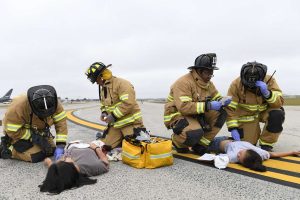2 Chapter 1: Introduction to the Fire Service and Firefighter Safety
Chapter Objectives
-
- Explain the mission of the fire service. [NFPA 1001, 4.1.1]
- Describe how fire departments are organized. [NFPA 1001, 4.1.1]
- Describe the various specializations within the fire service. [NFPA 1001, 4.1.1]
- Describe fire department SOPs, rules, and regulations that affect a Fire Fighter I. [NFPA 1001, 4.1.1, 4.1.2]
- Explain ways that fire departments may interact with other organizations and agencies. [NFPA 1001, 4.1.1]
- Explain the roles and duties of a Fire Fighter I. [NFPA 1001, 4.1.1]
- Describe fire and life safety initiatives aimed at reducing firefighter illnesses, injuries, and fatalities. [NFPA 1001, 4.1.1]
- Describe the aspects of NFPA 1500 related to firefighter safety and health. [NFPA 1001, 4.1.1]
- Describe fire department programs intended to reduce firefighter illnesses, injuries, and fatalities. [NFPA 1001, 4.1.1, 4.3.10]
- Summarize general guidelines for operating safely at structural fire scenes. [NFPA 1001, 4.3.3]
- Summarize safe practices for riding in fire service vehicles and apparatus. [NFPA 1001, 4.3.2, 4.3.3]
- Explain the use of emergency scene lighting and equipment. [NFPA 1001, 4.3.17]
- Explain the importance of personnel accountability systems. [NFPA 1001, 4.2.4, 4.3.5]
- Summarize general guidelines for operating safely at highway/roadway incidents. [NFPA 1001, 4.3.3]
You are about to join a highly respected and essential profession: the fire and emergency services. As a firefighter, you will be required to perform strenuous physical labor and manage mental and emotional stress. Your work environments contain a wide variety of hazards that could cause illness, injuries, or death to an unprotected and untrained person. To carry out your duties safely, you will have to master a variety of skills, make critical decisions quickly, and follow orders.
Your training will include learning fire and emergency services related knowledge, concepts, and skills. A small portion of the topics you will learn in your training includes, but is definitely not limited to, the following:
- The culture and mission of the fire and emergency services in North America
- Fire department organizational structure to include the positions, roles, and responsibilities of its members
- Fire department regulations, policies, and procedures
- Other agencies that routinely interact with the fire department
- Firefighter duties
- Fire dynamics
- Task-specific selection and use of tools and equipment
- Techniques for gaining access into a structure
- Techniques for applying extinguishing agents to control a fire
Completion of your entry-level firefighter training is only the beginning of your professional development as a firefighter. Throughout your fire and emergency services career, you will continue to learn new knowledge, skills, and techniques to help you advance through the ranks.
This chapter addresses:
- Fire service mission and organization
- Fire department regulations
- Departmental interaction with other agencies
- Roles and skills of the Fire Fighter I
- Reduction of firefighter injuries and fatalities
- Firefighter safety, health, and wellness
- Operational safety and scene management
Lesson 1
Outcomes:
- Explain the mission of the Fire Service.
- Describe how fire departments are organized.
- Describe the various specializations within the Fire Service.
Fire Service Mission
Fire Service is usually mandated by law or ordinance and enacted by an authority having jurisdiction (AHJ). AHJ determines what services are needed to protect citizens, and establishes fire services to meet the needs of different communities. Different communities require different types of services – Missions may vary among cities, provinces/territories, and regions. In the context of Indigenous communities in Canada, the AHJ may vary depending on the specific governance structure in place. For many Indigenous communities, particularly those located on reserves, the AHJ may be represented by the Indigenous Services Canada (ISC) or a designated Indigenous governing body. These entities work in collaboration with local fire departments and community leaders to assess fire protection needs, develop fire prevention strategies, and ensure compliance with relevant regulations. As each community has unique cultural, geographic, and jurisdictional considerations, the AHJ adapts fire services to meet the specific needs and challenges faced by Indigenous communities across the country.
The Mission of Fire Service
- Save lives
- Protect property and environment from fires, and other hazardous situations
Many departments take the All-Hazard Concept Approach to fire protection. They provide services such as:
- Community risk reduction (fire prevention, public education)

Figure 1.1 Modern fire and emergency services organizations provide a wide variety of services. Structural fire suppression photo courtesy of Bob Esposito, Pennsburg, PA. - Fire suppression
- Fire cause determination
- Emergency medical services (EMS)
- Technical rescue services
- Hazardous materials mitigation
- Airport and/or seaport protection
- Emergency management services
- A local department’s mission will depend on
- The legal mandate that established it
- Community needs
Your role in the Mission is to fulfill the objectives of your department’s mission statement and their stated goals. These goals and objectives will be part of your department’s rules and regulations and they can also be found posted in every department facility and made available to all personnel and members of the community.
Organization of Fire Departments
AHJ is responsible for establishing the way the Fire Service is organized. This includes:
- Type of department
- Number of facilities and their locations
- Types and numbers of apparatuses
- Number of personnel
- Organizational Hierarchy
- The functions, responsibilities for specific jobs, and ranks
- Minimum training, and certification level requirements to attain ranks
Every department is organized in such a way as to most efficiently meet its mission. This is based on an organizational structure and its principles. It needs to have an established foundation for how the organization will function and operate to achieve its mission(s).
The most common structure is scalar. Scalar follows a series of uninterrupted steps, and its decisions and information are directed from the top (Fire Chief) of the organizational structure down through intermediate levels and to the base of the structure. Feedback may then be given, and is the information transmitted from the bottom of the structure through to the top positions. The levels in between are composed of personnel assigned by rank and duty. When a person is promoted, the level of authority and responsibility is increased.
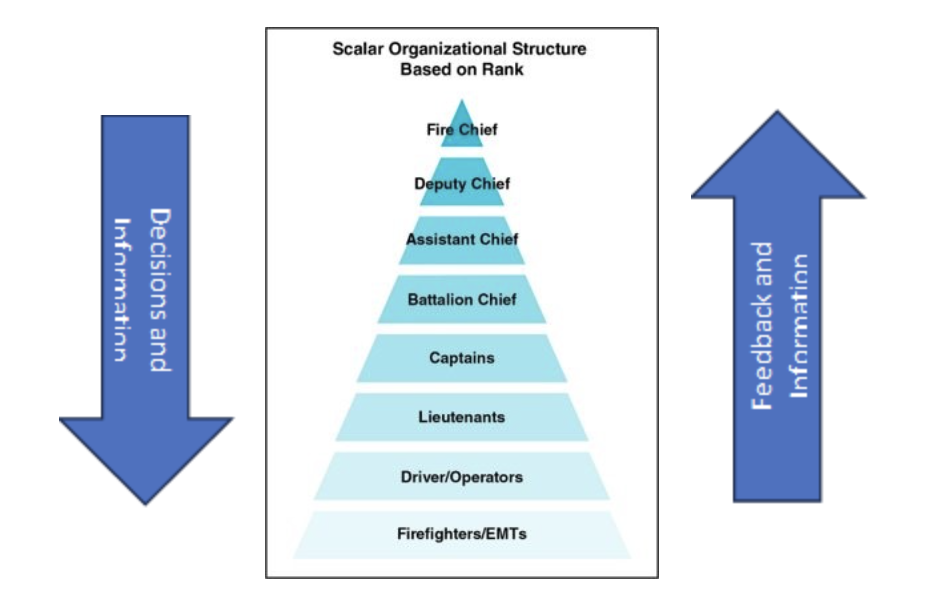
All fire and emergency services organizations adhere to the same basic organizational principles.

Chain of command: refers to the formal line of authority, responsibility, and communication within an organization. It can be visually represented on an organizational chart (Shown above), where the fire chief occupies the top position, and the firefighters are placed at the bottom. Adhering to the chain of command is essential as it helps maintain a sense of unity of command throughout the organization.
Unity of command: ensures a clear and streamlined organizational structure. Within this framework, each employee is accountable to a single supervisor, promoting effective communication and efficient decision-making. As personnel ascend the chain of command, they ultimately report to the fire chief, ensuring a cohesive and coordinated approach to operations.
Span of control: refers to the maximum number of subordinates or functions that a single supervisor can effectively manage. The range of subordinates or functions falls between three to seven, with five being considered the optimal number. This concept recognizes the practical limits of a supervisor’s ability to oversee and direct a cohesive and efficient team, striking a balance between managing a manageable workload and maintaining effective communication and coordination within the group.
Discipline: is a crucial aspect within an organization, involving both the responsibilities of the leadership and individuals. It encompasses the organization’s duty to provide effective leadership, while also emphasizing the individual’s responsibility to adhere to orders. This is achieved through the implementation of rules, regulations, and policies that establish standards for acceptable performance and expected outcomes. For discipline to be effectively enforced, these rules must be written and communicated throughout the entire organization, ensuring consistent understanding and adherence.
The division of labour is a vital practice that involves breaking down large jobs into smaller tasks. This approach serves several purposes, including making the workload more manageable, ensuring a fair distribution of responsibilities, and enhancing overall efficiency. In the context of the fire service, the division of labour becomes especially crucial. By assigning specific and clear-cut tasks to each team member, it becomes easier to allocate responsibility and prevent duplication of effort. Such a systematic approach ensures that everyone knows their role, resulting in a more effective and coordinated firefighting operation.
Types of Fire Departments
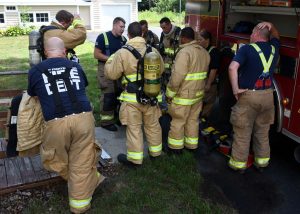 Fire departments can be categorized into two types: public and private. In North America, the majority of fire departments are publicly funded and operated. The funding for public fire departments primarily comes from the community they serve, which can be a municipality, county, district, or any other area defined by the Authority Having Jurisdiction (AHJ). This funding is obtained through various means, including taxes at the state/provincial and federal levels, fees, grants, fundraisers, donations, and contracts. On the other hand, private fire departments are organizations that rely on alternative sources of revenue. They raise money through contracts, billing for services rendered, and revenue provided by their parent organization. Private fire departments may offer their services to a single company, facility, or specific municipality.
Fire departments can be categorized into two types: public and private. In North America, the majority of fire departments are publicly funded and operated. The funding for public fire departments primarily comes from the community they serve, which can be a municipality, county, district, or any other area defined by the Authority Having Jurisdiction (AHJ). This funding is obtained through various means, including taxes at the state/provincial and federal levels, fees, grants, fundraisers, donations, and contracts. On the other hand, private fire departments are organizations that rely on alternative sources of revenue. They raise money through contracts, billing for services rendered, and revenue provided by their parent organization. Private fire departments may offer their services to a single company, facility, or specific municipality.
There are many different types of departments these may include:
Career departments
Career departments are commonly found in large cities and certain counties, as they maintain facilities and equipment dedicated to providing necessary services. These departments often employ full-time firefighters and other personnel who are committed to their careers. Career organizations are prevalent in departments that serve military installations and private industrial sites. These full-time departments are staffed around the clock, ensuring that emergency responders are always available. To be readily accessible, emergency responders typically reside in the fire station while on duty. Administrative staff members, on the other hand, typically follow conventional working hours.
Volunteer departments
Volunteer departments are fire departments that may be overseen either by the local government or operate independently with an elected board of directors. Unlike fully staffed fire departments, volunteer departments do not have a continuous presence of firefighters on-site. Instead, volunteers respond to emergencies when needed. While some volunteer departments receive public funding from the town or county, which covers the expenses for facilities, equipment, and maintenance, others rely on alternative funding sources. These may include subscription fees, fundraising events, and billing customers for the costs associated with emergency response services. 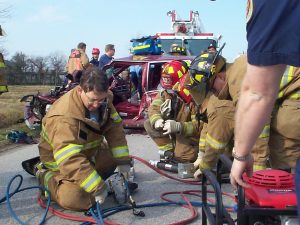
Combination departments
Combination departments are fire departments that are staffed by a combination of career and volunteer firefighters. In Canada, these departments are referred to as composite departments. Moreover, federal combination departments have the distinction of including both government and civilian personnel among their ranks.
Fire Companies
Fire companies are the fundamental building blocks of firefighting operations. They encompass a team of firefighters along with their apparatus, led by a company officer. The staffing levels of these companies are determined by the authority having jurisdiction (AHJ). In a response area, there are usually multiple fire companies, which are further organized into battalions or response districts. The day-to-day functions of these companies are overseen by the operations division. Overall, fire companies play a crucial role in ensuring effective firefighting and emergency response.
** NOTE: There are different types of Fire companies based on local needs. Large departments are the most specialized, while in smaller departments a single company typically performs all functions. **
| An Engine Company is responsible for performing fire suppression duties in various scenarios such as structural, vehicle, wildland, and other types of fires. In addition to firefighting, they may also have additional duties that encompass search and rescue operations, extrication, ventilation, and emergency medical care. These versatile firefighters are typically assigned to pumping apparatus, equipped with the necessary tools and resources to effectively combat fires and handle emergencies. | 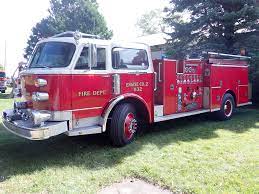 |
| The Truck (Ladder) Company is responsible for a range of essential tasks during emergencies. They perform forcible entry, search and rescue, ventilation, salvage, overhaul, and utility control. Additionally, they provide access to upper levels of structures, enabling efficient operations. Moreover, they may offer elevated water streams, extrication services, and even emergency medical care when needed. The Truck (Ladder) company plays a crucial role in ensuring the safety and effectiveness of emergency response efforts. |  |
| A Rescue Company is a specialized unit that focuses on searching for and extracting individuals who are in hazardous or trapped situations. They are skilled in identifying areas of danger and safely removing victims from those situations. In addition, some rescue companies receive specialized training to perform technical rescues, which involve complex and challenging rescue scenarios. Rescue companies may also function as rapid intervention crews (RIC), providing immediate assistance and support in emergencies. Overall, rescue companies play a crucial role in ensuring the safety and well-being of individuals in perilous circumstances. | 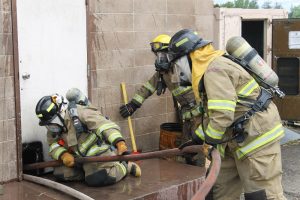 |
| The Brush Company specializes in providing effective solutions for managing ground cover or grass fires. Additionally, they will provide protective measures for structures located near fields and woodlands, ensuring their safety from potential fire hazards. Their comprehensive approach combines fire suppression techniques with proactive strategies. | 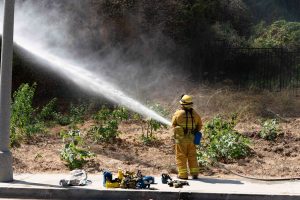 |
| The Hazardous Materials Company specializes in mitigating hazardous materials
incidents. With their expertise and resources, they diligently work to address and resolve situations involving dangerous substances. Their comprehensive approach focuses on minimizing risks, implementing safety protocols, and efficiently handling hazardous materials to prevent accidents and protect both people and the environment. |
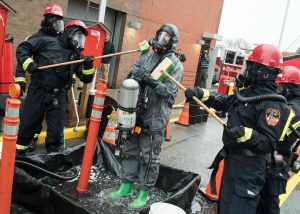 |
| The Emergency Medical/Ambulance Company provides immediate and critical medical care in urgent situations. Their primary function is to deliver prompt medical assistance to individuals in need. Additionally, these companies may also offer transportation services, ensuring that patients are safely and efficiently transported to a medical facility where they can receive further treatment and care. |  |
| An Aircraft Rescue and Firefighting (ARFF) Company specializes in handling emergencies related to aircraft incidents. They are equipped and trained to swiftly respond to incidents involving aircraft and perform rescue operations as well as fire suppression activities. |  |
Staffing
Fire Service staff is classified based on whether or not the firefighters are paid and how often they work. There are two main categories: career firefighters and volunteer firefighters.
- Career firefighters are full-time, paid employees of their jurisdiction. They adhere to a required work schedule and receive regular pay and benefits.
- Volunteer firefighters may or may not work on a set schedule. They are obligated to attend regular training sessions and participate in station workdays. While some volunteer firefighters may work full-time, they are not considered jurisdictional employees. Within the realm of volunteer firefighting, there are various types of arrangements, such as part-time paid, paid-on-call, fully volunteer, or a combination of these.
Part-time and paid-on-call firefighters usually do not reside in the fire station. Instead, they are summoned to the station or emergency scene through telephone, pager, or community signals. They are compensated either by an hourly wage or a set fee per response. This form of compensation can also be used in full-time career organizations to remunerate part-time personnel.
In some firefighting organizations, personnel are divided into two groups: line personnel and staff personnel. Line personnel are responsible for delivering emergency services to the public. On the other hand, staff personnel provide administrative and logistical support to line personnel in areas such as finance, maintenance, and training. In certain departments, staff officers also deliver services to both internal and external customers. Both line and staff functions are critical to the successful operation of firefighting organizations.
Fire Service Specializations
The National Fire Protection (NFPA) 1001, Standard for Fire Fighter Professional Qualifications is the guide most jurisdictions follow when deciding on the hiring criteria for firefighters. It establishes basic criteria for two levels of competency/professionalism: Fire Fighter I and Fire Fighter II.
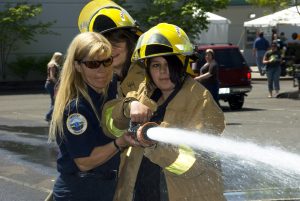
To be considered for employment by a fire department, candidate must meet the following basic criteria:
- Minimum educational requirements
- Set by AHJ
- Usually high school diploma or general education diploma (GED)
- Age requirement
- Set by AHJ
- May have maximum limit based on local or state/provincial pension law
- Medical requirements
- Outlined in NFPA 1582, Standard on Comprehensive Occupational Medical Program for Fire Departments
- Job-related physical fitness requirements
- set by AHJ
Additionally, candidates must be able to provide basic medical care including:
- Cardiopulmonary resuscitation (CPR)
- Bleeding control
- Infection control
- Shock Management
** NOTE: If they do not already possess these skills, they may be able to receive training from the department. Additionally, some departments may require candidates to be certified EMS First Responders, Emergency Medical Technicians (EMTs), or Paramedics. **
Table 1.1 details where you will find any additional qualifications for specialized departments.
Lesson 2
Outcomes:
- Describe fire department SOPs, rules, and regulations that affect a Fire Fighter I.
Fire Department Regulations
Fire Department Regulations consist of written regulations that clarify expectations, delegate authority, and assign responsibility based on the organization’s structure and mission. These regulations also consist of policies and procedures that govern the department and its employees. They are not only governed by municipal ordinances but also by state/provincial and federal laws, as well as codes and standards adopted by the AHJ.
For fire departments that have labor/management relationships with a union or bargaining agent, there is a written contract in place that directly affects its members. A copy of this contract is usually provided to all members and maintained in every workplace.
It is every individual’s responsibility to learn and adhere to the department’s regulations. To fulfill this responsibility, individuals must be able to locate the relevant documents and find the parts that apply to their duties, authority, and responsibility.
To provide access to these regulations, organizations distribute them in written or electronic format. They also communicate them verbally to all members and post them in a conspicuous place in all facilities.
In case of any questions or doubts regarding the regulations, it is important to know where to find them. If an individual is unsure, they should ask their supervisor, who may be able to answer the question directly or guide them to the appropriate documents. Regulations are always filed in the administrative office, and each station, facility, or division typically keeps a copy. Any new policies or amendments should be posted on bulletin boards to ensure everyone is aware of them.
Policies
Policies play a crucial role in guiding decision-making within an organization. They are typically determined by the top management and then distributed to lower ranks for implementation. The main purpose of policies is to set boundaries and establish standards of conduct that the organization expects from its members.
These policies address various issues such as working hours, emergency response guidelines, and the chain of command. They provide clarity and consistency in these areas, ensuring that everyone in the organization understands and follows the established protocols.
Some policies may be created in response to government mandates, such as certification training requirements or changes to operational needs. Most policies involve written criteria, outlining the specific guidelines and expectations. However, there are also unwritten policies known as organizational norms or past practices.
These unwritten policies are typically a result of the organization’s traditional approach to routine tasks. They are implied rather than formally stated, and they often arise when there is no clear policy in place or existing policies are outdated. However, it is important for organizations to create clear, written policies to avoid any potential dangers or legal liabilities.
Without clear policies, there may be consequences that pose risks to the organization, such as legal liability. Therefore, it is crucial for organizations to prioritize the creation and communication of well-defined policies to ensure smooth operations and compliance with legal and ethical standards.
Procedures
Procedures serve as roadmaps, outlining specific steps to be taken when faced with a known challenge or circumstance. In many organizations, such plans are encapsulated in Standard Operating Procedures (SOPs). SOPs are comprehensive documents that are made available to personnel within the organization. Their purpose is to provide clear instructions and guidelines on how to perform specific tasks to meet the required standards. They ensure consistency and uniformity in the execution of tasks across the organization.
Another form of guidance that organizations utilize is Standard Operating Guidelines (SOGs), which are similar in nature to SOPs. However, SOGs may offer firefighters some flexibility or discretion in certain situations, in contrast to SOPs that are typically rigid and inflexible rules. This allowance for leeway enables firefighters to make informed decisions based on the unique circumstances they face. While SOPs provide strict protocols to be followed, SOGs offer a degree of autonomy and judgment, acknowledging that not every situation can be anticipated or governed by predetermined rules. Together, SOPs and SOGs play vital roles in guiding personnel and promoting efficiency, safety, and adaptability within organizations.
Lesson 3
Outcomes:
- Explain the ways that fire departments may interact with other organizations and agencies.
Departmental Interaction with Other Agencies
The Fire department is one of many organizations that provide services to the public during emergencies. To work efficiently with members of these organizations you need to know the types of service they provide.
Fire departments frequently interact with the following agencies and organizations:
- Emergency medical services and local hospitals: EMS organizations may provide complete medical services or they may supplement the services provided by the fire department.
- Emergency/Disaster Management: These agencies manage emergency and disaster response by coordinating multi-agency activities. The agency may be local, state/provincial, or federal.
- Law enforcement: law enforcement agencies may assist with incident scene security, traffic and crowds control, firefighter protection, fire investigation, and explosives disposal.
- Utility companies and public works: utility personnel assist at incidents by shutting off natural gas lines, electricity, or public water mains. Public works departments typically oversee the construction and maintenance of public roads, buildings, and sewers. Either of the entities may manage the hydrants and hydrant testing in the jurisdiction.
- Media: The media can alert the public of traffic incidents, evacuations, and fire department activities. They can also inform the public about fire and life safety topics and initiatives.
Lesson 4
Outcomes:
- Explain the roles and duties of a Fire Fighter I
Roles and Skills of the Fire Fighter I
Your entry-level training will prepare you for your position as a firefighter within your department. As a Fire Fighter I working with a team of emergency responders, you will assist other team members in meeting the incident priorities of life safety, incident stabilization, and property conservation. You should be trained to the level of competency determined by the AHJ. This training encompasses the responsibilities outlined by the NFPA 1001 for the Fire Fighter I.
Firefighters are expected to establish work areas at emergency scenes, force entry into structures, and set up and utilize ground ladders. They are also responsible for extinguishing fires as part of a team, which includes dealing with structure fires, ground cover fires, vehicle fires, and fires in stacked materials. Additionally, firefighters are trained to conduct search and rescue operations within structures as part of a team.
Firefighters also play a vital role in post-fire activities. This involves overhauling the fire scene to ensure complete extinguishment and conserve property. They can set up electrical and lighting equipment as needed. Furthermore, firefighters possess the knowledge to tie knots appropriate for hoisting tools, connect pumpers to hydrants, and perform hose lays for fire attack.
Firefighters are trained to handle a wide range of responsibilities, including the ability to turn off building utilities, route emergency and nonemergency telephone calls, and effectively communicate over department radios using appropriate procedures. They are also responsible for cleaning, inspecting, and maintaining various types of equipment such as ladders, ventilation equipment, self-contained breathing apparatus (SCBA), ropes, salvage equipment, hand tools, hoses, and protective clothing. Additionally, firefighters are proficient in preparing apparatus hose loads for swift response.
(SCBA maintenance)
Lesson 5
Outcomes:
- Describe fire and life safety initiatives aimed at reducing firefighter illnesses, injuries, and fatalities.
- Describe the aspects of NFPA 1500 related to firefighter safety and health.
- Describe fire department programs intended to reduce firefighter illnesses, injuries, and fatalities.
Reduction of Firefighter Injuries and Fatalities
Reduction of firefighter illnesses, injuries, and fatalities is an ongoing challenge within the fire service. Although most people would assume that firefighters die as a result of poor health habits, or occupational stress. Firefighters are often injured or killed in motor vehicle incidents while responding to and returning rom emergencies. Firefighters may also be injured or killed as a result of emergency scene hazards such as structural collapses or rapid changes in fire development.
The following organizations publish annual statistics, information, investigations, and recommendations about firefighter fatalities and injuries:
- National Fire Protection Association (NFPA)
- United States Fire Administration (UFSA)
- National Institute for Occupational Safety and Health (NIOSH)
- Occupational Safety and Health Administration (OSHA)
- National Near-Miss Reporting System
- National Institute of Standards and Technology (NIST)
The 16 Firefighter Life Safety Initiatives
The U.S. Congress created the nonprofit National Fallen Firefighters Foundation (NFFF) in 1992. Its mission is “to honor and remember America’s fallen fire heroes, to provide resources to assist their survivors in rebuilding their lives, and work within the Fire Service Community to reduce firefighter deaths and injuries.” Annually, the Foundation honors those firefighters who died in the line of duty during the previous year. They also honor the families of those firefighters.
In 2004, the Foundation developed 16 Firefighter Life Safety Initiatives to provide the fire service with a blue-print for making changes. Currently, the foundation is working to establish training on the Fire and Life Safety Initiatives throughout the fire service in the United States.
The 16 Firefighter Life Safety Initiatives, also known as Everyone Goes Home, are:
- Define and advocate the need for a cultural change relating to safety; incorporating leadership, management, supervision, accountability and personal responsibility.
- Enhance personal and organizational accountability for health and safety.
- Focus greater attention on the integration of risk management with incident management at all levels, including strategic, tactical, and planning responsibilities.
- All firefighters must be empowered to stop unsafe practices.
- Develop and implement national standards for training, qualifications, and certification (including regular recertification) that are equally applicable to all firefighters based on the duties they are expected to perform.
- Develop and implement national medical and physical fitness standards that are equally applicable to all firefighters, based on the duties they are expected to perform.
- Create a national research agenda and data collection system that relates to the initiatives.
- Utilize available technology wherever it can produce higher levels of health and safety.
- Thoroughly investigate all firefighter fatalities, injuries, and near misses
- Grant programs should support the implementation of safe practices and/or mandate safe practices as an eligibility requirement.
- National standards for emergency response policies and procedures that should be developed and championed.
- National protocols for response to violent incidents should be developed and championed.
- Firefighters and their families must have access to counseling and psychological support.
- Public education must receive more resources and be championed as a critical fire and life safety program.
- Advocacy must be strengthened for the enforcement of codes and the installation of home fire sprinklers.
- Safety must be a primary consideration in the design of apparatus and equipment.
Safety Stand-Down
The International Association of Fire Chiefs (IAFC) initiated a Fire Fighter Safety Stand-Down in 2005. The purpose of the annual day-long stand-down (typically held on each work shift in the third week in June) is to focus on firefighter safety. All nonemergency work ceases, and safety training sessions are held. Topics include safety-related procedures, policies, and skills.
Lesson 6
Outcomes:
- Describe the aspects of the NFPA 1500 related to firefighter safety and health.
- Describe the fire department programs intended to reduce firefighter illnesses, injuries, and fatalities.
Firefighter Safety Health and Wellness
Firefighting is one of the most hazardous professions. Traditionally, firefighters have accepted injuries as a part of their job. This attitude has been compounded by the stereotypical image of the firefighter as heroic and fearless in the face of danger. However, the fire service culture has progressed to a more safety-conscious image. Firefighters now understand that these injuries, illnesses, and fatalities are preventable and can be avoided. Departments should have a health and safety plan which is intended to create a safe working environment.
Numerous occupational safety standards and regulations address the inherent danger of firefighting. The most prominent of these come from the NFPA and the U.S. Occupational Safety and Health Administration (OSHA). NFPA 1500, Standard on Fire Department Occupational Safety and Health Program specifies the minimum requirements for a fire department safety and health program. It may be applied to any fire department or similar organization, public or private.
Because it is a minimum standard, any department or jurisdiction is free to exceed the standard’s specified requirements. Many governing bodies in both the U.S. and Canada have chosen to adopt one or more of the NFPA standards into their laws and ordinances.
Among the topics included in NFPA 1500 are the following:
- Safety and health-related policies, procedures
- Training and education
- Fire apparatus, equipment, driver/operators
- Protective clothing and equipment
- Emergency operations
- Facility safety
- Medical, physical requirements
- Firefighter wellness programs
- Member assistance programs
- Infection, exposure control program
Safety and Health-Related Policies and Procedures
Safety and health are important aspects of fire service culture. To perform your duties as a firefighter you must take a proactive approach to safety, health, and fitness. The departmental safety and health program must address all anticipated hazards to which members might be exposed, such as:
- Hazardous materials releases
- Communicable diseases
- Energized electrical equipment
- Driving/riding in apparatus during emergency responses
- Nonemergency issues, such as substance abuse (both on and off duty)
- Other hazards associated with fire fighting
Training and Education
NFPA 1500 Outlines requirements of a fire department training program in order to prevent occupational illnesses, injuries, and fatalities. Requirements include initial training for new recruits, methods for becoming proficient in firefighter’s duties, and a process for evaluating firefighter skills and knowledge. Personnel may not be assigned to firefighting duties until they have completed the required skills and evaluation and training. This training must meet the requirements of the NFPA 1000 series of professional qualifications (ProQual) standards. All such training must be thoroughly documented.
Annual proficiency training and evaluation are required to ensure that members maintain their knowledge and skills. Training is also required whenever policies, procedures, or guidelines are updated.
While it is important to train in conditions that are close to actual emergencies, it is unacceptable for training to result in injuries or fatalities. You must follow the orders if your superiors and training officers, adhere to safety policies and procedures, and stay aware of your own physical limitations.
Maintaining personnel safety during training evolutions includes:
- Using appropriate protective clothing and equipment (PPE)
- All personnel in training should be fully clothed in appropriate PPE
- PPE must be used for:
- Raising ladders
- Deploying hose
- Operating extrication tools
- Performing any activity that simulates actual emergency scene conditions
- Maintaining situational awareness
- Maintain at all times during live fire training
- Apply knowledge of fire dynamics
- Listen to instructors
- Remain with team or partner
- Remain calm, take slow, regular breaths
- Breathing rapidly uses your air supply faster and reduces the time you have to work in a hazardous atmosphere
- Be aware of physical condition
- Tell your supervisor if you’re feeling stressed or overheated
- Take advantage of the rehabilitation breaks
- Stay hydrated
- Being healthy and in good physical condition
- Yours and your fellow trainees training safety is influenced by your physical condition
- Physical discomfort or illness can make you less alert and more prone to injury
- Consult a physician for an evaluation before participating in training if you experience any severe physical discomfort or illness
- Adhering to all safety regulations
- You Must remain focused on training exercise at all times
- Rowdy play or unprofessional conduct not allowed. It is distracting and can lead to accidents and injuries.
- How you train determines how you will perform in the field
- Maintaining PPE and training equipment
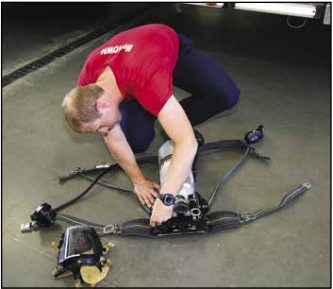
A cadet firefighter inspecting an SCBA as part of learning how to maintain personal protective equipment. - Equipment used for training evolutions can wear out faster than equipment used less frequently on emergency calls
- You must inspect and clean tools, equipment, and PPE assigned to you for training
- Clean your PPE thoroughly when contaminated with smoke or soot
- Disinfect SCBA facepiece, CPR manikins, and medical equipment after each training session
- Report any items needing repaired or replaced to supervisor
- The way you maintain training equipment will be the way you maintain equipment on duty
Fire Apparatus, Equipment and Driver/Operators
NFPA 1500 establishes safety requirements for all uses of fire department apparatus. Design requirements include restraint devices (seat belts) for all apparatus occupants. The department must maintain maintenance and inventory records for all equipment.
The standard also establishes minimum requirements for driver/operators. It requires that they wear a seatbelt, obey all traffic signals and regulations, and be thoroughly trained before operating the apparatus in an emergency.
Personal Protective Equipment (PPE)
NFPA 1500 requires all personnel operating in an immediately dangerous to life and health (IDLH) atmosphere or hazardous area to be fully equipped with PPE, including self-contained breathing apparatus (SCBA). Fire departments should provide all members with at least one full set of protective clothing (preferably two) and appropriate protective equipment. Protective clothing must comply with the appropriate NFPA design standard. The edition of the standard it complies with is the edition that was current when the clothing was manufactured.
Protective equipment can refer to:
- Respiratory protection such as SCBA and supplied-air respirators (SARs)
- Body armour for personnel responding to potentially violent incidents
- Protection against blood and airborne pathogens
- Hearing protection

Emergency Operations
NFPA 1500 requires that emergency operations be managed through an incident management system (IMS), also known as the incident command system (ICS). The system must include a risk management plan and a personnel accountability system.
The standard limits emergency operations to those that can be safely conducted by personnel on scene. Emergency operations must include rapid intervention crews for firefighter rescue, rehabilitation facilities, and post incident analysis.
Facility Safety
All fire service facilities need to reflect the service’s focus on safety. NFPA 1500 sets minimum design requirements for fire department facilities such as fire stations, training centers, administration buildings, and maintenance shops. These facilities need to be designed and constructed in compliance with NFPA 101, Life Safety Code®. Facilities must have a space and means for cleaning, disinfecting and storing infection control devices. The standard also requires inspection, maintenance and prompt repairs and prohibits all tobacco use in facilities.
Medical and Physical Requirements
All firefighters must comply with the medical and physical requirements of the AHJ. Some of the requirements of NFPA 1500 include:
- Medical evaluations to ensure candidates can perform duties
- Development of physical performance standards for hiring emergency responders
- Availability of a designated physician to advise personnel about health and wellness issues
- Establishment of job-related physical fitness standards
- Establishment of fitness program that allows members to maintain required level of fitness
- Annual medical exams to verify continued fitness
- Documentation of all on-the-job injuries and exposures
- Operation of an infection control program
- Medical records for all personnel must be kept in confidential health database
- Prohibition of firefighters participating in fire department operations when under influence of alcohol or drugs
Firefighter Wellness Program
NFPA 1500 requires fire service organizations to establish wellness programs and initiatives. These programs are intended to guide firefighters toward a healthy lifestyle and maintain their fitness-for-duty. Wellness programs overall are meant to help reduce firefighter illnesses, injuries, and fatalities by ensuring that firefighters are healthy.
You should adopt safe behaviours and a healthy lifestyle. If you exercise and eat a healthy diet, your body will be better able to withstand stress. In career departments, firefighters are typically required to participate in a physical fitness program. In volunteer departments, firefighters must establish their own regimen to remain fit for duty.
Good nutrition is also important to prevent you from becoming overweight. Being overweight can lead to cardiovascular disease, diabetes, and musculoskeletal injuries. These conditions affect your overall health and may make you unfit for duty.

To maintain your personal health, follow these general guidelines:
- Stay informed about job-related health issues.
- Wear incident-appropriate PPE.
- Clean all PPE at least twice annually and after every exposure to smoke.
- Follow recommendations for vaccination against hepatitis B.
- Use precautions to avoid exposure to airborne and bloodborne pathogens.
- Use proper lifting techniques to avoid muscle strains and related injuries.
- Use lifting tools or get help with lifting heavy objects.
- Clean, disinfect, properly store tools and equipment used in patient care.
- Maintain a regular exercise program.
- Maintain a diet low in cholesterol, fat, sodium.
- Reduce heart attack and stroke risk by maintaining blood pressure and cholesterol levels within acceptable limits.
- Reduce cancer risk by eliminating use of tobacco products.
- Have regular physicals, medical checkups.
A wellness program should also offer counselling and education for firefighters struggling with health-related problems, such as:
- Nutrition
- Hypertension
- Weight control
- Physical conditioning

Injuries
Physically fit firefighters are more productive and less likely to suffer injuries. Firefighter injuries range from minor strains and sprains to those requiring hospitalization and lost duty time. Injuries can occur at any time, such as during training, during all types of operations, and while responding to or returning from incidents.

Firefighter injuries can be prevented by:
- Providing effective training
- Maintaining company discipline, accountability
- Following established safety-related SOPs
- Using personal protective clothing and equipment
- Maintaining high levels of physical fitness
- Following risk management guidelines
- Using rehabilitation facilities at emergency incidents
Illnesses
Acute and Chronic illnesses are another source of lost duty time. Acute illnesses such as cols and viruses, last only a few days and result in little lost duty time. Chronic illnesses, such as cancer or diabetes are long-lasting and can even be fatal. Chronic illnesses could be behavioural, or they could be as a result of exposures to chemicals or products of combustion in your work environment. For example, research is beginning to prove that the products of combustion encountered during firefighting may result in a greater instance of cancer among firefighters later in life.
Cardiovascular disease is the leading cause of firefighter fatalities.
Some of the work-related causes include:
- Exposure to smoke and chemicals
- Heat stress from fires and high temperatures
- Psychological stress
- Long, irregular work hours
These causes can be mitigated by departmental policies, procedures, and equipment as part of the wellness program. Your responsibility is to adhere to these policies and procedures, wear required PPE, and reduce exposure to hazards.
Some of the non-job-related causes include:
- Obesity
- Tobacco use
- Lack of physical fitness
- Can be controlled by healthy diet and ceasing tobacco use.
- Physical exercise helps lower stress, reduces risk of cardiac arrest and stroke.
Common respiratory diseases include asthma, lung cancer, and chronic obstructive pulmonary disease (COPD). Respiratory diseases are typically caused by cigarette smoking, but firefighters are also exposed to smoke, gases, and chemicals (such as carbon monoxide and phosgene). Wearing proper respiratory protective equipment can help you avoid these deadly hazards.

Always follow departmental regulations for wearing respiratory protective equipment. Never remove your SCBA during structural firefighting until your supervisor or the Incident Commander (IC) says it is safe to do so. Always wear protective equipment in situations that are IDLH. Choose the appropriate level of protection during medical emergencies or when working around paints, thinners, cleaners, dust, or particulates.
Smoking or being exposed regularly secondhand smoke will deteriorate your respiratory efficiency and could lead to respiratory disease over time. A healthy lifestyle, including not smoking, helps ensure that you have the lung capacity to perform your duties.
Cancer
Fire research continues to demonstrate that numerous carcinogens are present in almost all types of fires. Today’s firefighters are faced with fires that emit toxic gases, vapors, and particulate matter in smoke contaminating their protective equipment. This contamination increases the likelihood ofdermal contamination and the severity of respiratory injuries. With the prevalence of manufactured products in residential, commercial, automobile, and industrial fires, the amount and variety of contaminants are significantly higher compared to traditional construction fires.
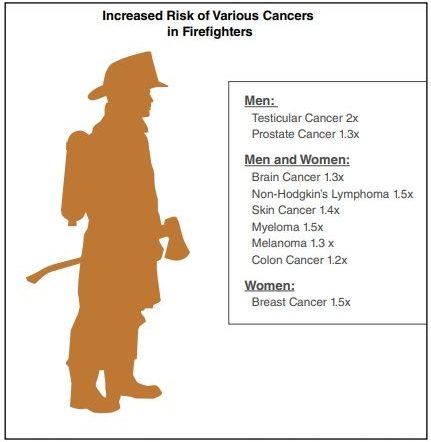
These manufactured products tend to burn at higher temperatures. As temperatures increase so does the skins ability to absorb chemicals deposited on it. In fact, absorption rates surge by 400% for every 5-degree rise in temperature. Areas with the highest absorption rates include the groin, jaw, forehead, and back, while the arms, hands, and ankles also experience increased absorption to a lesser extent. Consequently, firefighters face a heightened risk of developing cancer in these highly absorbent areas (Taking…2013). Increased rates of absorption combined with increased amounts of toxic chemicals mean firefighters are more likely to be contaminated.
To address this issue, the wellness program should include strategies to mitigate the risk of cancer. A collaborative study is currently underway between the University of Illinois Fire Service Institute (IFSI), the UL Firefighter Safety Research Institute (FSRI), and the National Institute for Occupational Safety and Health (NIOSH). This study focuses on investigating the cardiovascular and chemical exposure risks associated with modern firefighting.
The interim report (Horn, et al, 2016) identified several immediate recommendations for preventing or limiting chemical exposures at fires:
- Always wear SCBA when working in or around damaged structures
- Remain upwind of fires, smoke plumes — Wear SCBA if in smoke plume or around diesel exhaust
- Doff contaminated gear before entering rehab area
- Do not wear or store contaminated turnouts inside apparatus cab, personal vehicle compartments, or station or home living areas
- Decontaminate and/or launder turnouts, fire hood, other equipment that readily contacts skin after each fire response
- Wash hands and neck skin immediately after fire and shower as soon as possible
Obesity
Wellness programs are being implemented to combat obesity by promoting healthy habits. These habits include adopting a nutritious diet and mandating regular exercise as a requirement to pass fit-for-duty evaluations. Being obese puts additional strain on the body, making it more challenging to perform daily duties effectively. Moreover, individuals who are overweight or obese are at a higher risk of  developing various health conditions including:
developing various health conditions including:
- Type 2 diabetes
- Coronary heart disease
- Stroke
- Hypertension
- Certain forms of cancer:
- Breast
- Colorectal
- Endometrial
- Kidney Cancer
Addressing obesity and its associated risks is crucial for maintaining overall well-being and reducing the burden on both individuals and society.
Infection and Exposure Control Programs

NFPA 1500 requires infection and exposure control programs to be in place. Firefighters can experience short-term (acute) and/or long-tern (chronic) health consequences from exposure to infectious diseases, Chemicals, products of combustion, engine exhaust and other occupational, environmental exposures. Firefighters should take every precaution to reduce exposures, maintain heightened health and utilize all safety equipment available.
Treating medical patients can expose you to AIDS, TB, MRSA, C-diff and many other communicable diseases. To protect yourself you should limit physical contact, maintain the recommended separation distance, always wear appropriate PPE and use body substance isolation (BSI) methods to treat all patients. Some departments may also provide and/or require vaccinations against some diseases such as hepatitis.
Test your knowledge!
Member Assistance Programs
A member assistance program (MAP) provides services to both firefighters and their families. Chapter 11 of NFPA 1500 includes MAP as part of the overall Behavioural Health and Wellness Programs required. A MAP offers easily accessible, confidential assistance with personal problems that can affect job performance. It provides education, counselling, referrals to professional services for concerns such as:
- Substance abuse
- Tobacco use
- Personal problems
- Stress
- Depression
- Anxiety
- Marital problems
- Financial problems
By knowing what services MAP provides, firefighters should take full advantage and not let personal issues go unattended. Utilizing MAP services can help firefighters maintain a healthy lifestyle and remain fit for duty.
Substance Abuse
Drugs and alcohol impair your ability to function and slow your reaction time. As a firefighter you have a responsibility to be fully cognizant and emergency ready when on duty. Most departments prohibit firefighters from responding to an emergency if that have consumed alcohol or are taking prescription drugs that cause impairment. Some departments also prohibit candidates from consuming alcohol.
You are responsible for controlling your use of drugs and alcohol when on-call and prior to reporting for full duty. You must not respond to a call or report to the station if you are under the influence of drugs or alcohol, or taking any medication that causes impairment.

Tobacco use/dependence
Tobacco use can cause cancer, heart disease and COPD and can make other chronic diseases last longer. Many departments prohibit tobacco use (smoking/chewing/dipping) within all facilities and may require probationary firefighters to not use tobacco and offer tobacco cessation programs for members who do use. if you do not use tobacco, do not start, and if you do, take advantage of one of the many programs available for help in stopping its use.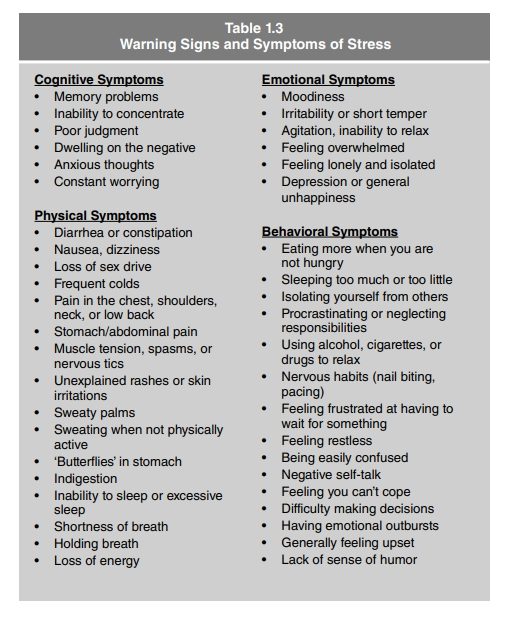
Occupational stress
Occupational stress is a contributing factor to stress-induced hypertension, one type of cardiovascular disease. The damage it does to your body accumulates over time and can take years to develop. Controlling stress can be difficult, but its effects can be mitigated by staying in good physical condition, having a positive mental attitude, relaxing when possible, and utilizing a personal stress management program. If your personal stress management program is not working, the organization’s MAP should be able to assist.
Atypically stressful events
Level of stress firefighters deal with on a regular basis is greater than that of most civilians. Firefighters can experience events more stressful, or atypical, than they routinely encounter in day to day life. Individuals may be able to cope with some amount of stress on their own, but they may need professional help when dealing with atypically stressful events.
Historically, the Critical Incident Stress Management (CISM) method of dealing with atypically stressful events, would be to conduct a critical Incident Stress Debriefing (CISD) shortly after the event. This involves having a counsellor speak with the personnel involved in the event and encourage them as a group to speak about their collective experiences.

However, recent researched referenced in NFPA standards revealed that CISD is not as effective as once thought and may have made situations worse. Now it is recommended that officers and supervisors monitor personnel following atypically stressful event for signs of post-traumatic stress disorder (PTSD). This would be a sign that individual(s) experiencing difficulty resolving the event. The Officer or supervisor should then confidentially recommend that individuals receive assistance from licensed/certified specialists. Some personnel may see signs of stress within coworkers and may report concerns to the individual or their supervisor. Individuals may and are encouraged to self-report a need for assistance.
Personnel should be trained to recognize the signs of PTSD. Potential indicators of PTSD include but are not limited to:
- Substance abuse
- Disconnection with the world around them
- Trouble sleeping
- Irritability
- Lack of concentration
- Hypersensitivity to stimuli
- Disproportionate reactions to everyday events
- Tunnel vision
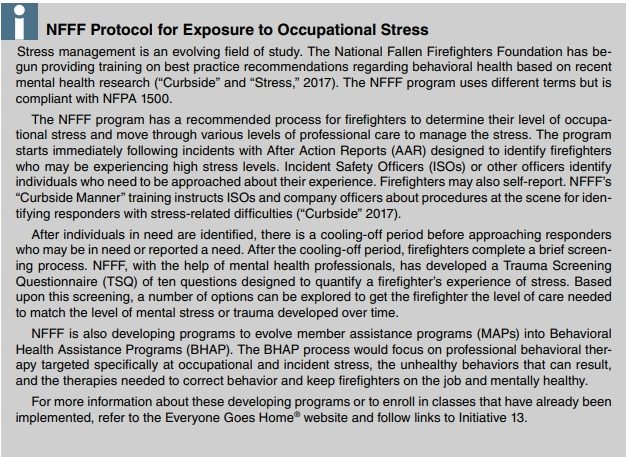
Lesson 7
Outcomes:
- Summarize general guidelines for operating safely at structural fire scenes.
- Summarize safe practices for riding in fire service vehicles and apparatus.
- Explain the use of emergency scene lighting and equipment.
- Explain the importance of personnel accountability systems.
- Summarize general guidelines for operating safely at highway/roadway incidents.
Operational Safety and Scene Management
As a firefighter, you must be prepared to respond to an emergency at a moment’s notice. While responding to an emergency and operating at an emergency scene, you must follow safe practices and procedures such as response safety, structural fire scene safety, and highway/roadway incident scene safety.
Situational Awareness: Safe Operation
As a Firefighter I, you will be expected to receive and follow instructions from supervisor, crew leader, company officer, or Incident Command Officer (IC) on the fireground. Your primary role is to safely, efficiently perform tasks assigned to you, it is also Imperative to maintain situational awareness throughout the entire operation. Situational awareness is recognizing, remaining mindful of identified hazards, remaining observant about changing conditions on the fireground, evaluating changes against the safety of what you are doing. A large part of situational awareness is simply communicating what you see to your immediate supervisor, crew leader, company officer, or IC. New information may lead them to change their orders and strategies during an incident. In this section Situational awareness will be highlighted in various areas to illustrate changes or conditions that can affect your safety during operations. The following conditions are what you should observe at every incident and are very general. They will be expanded on later in this course.
- Location of the fire and your proximity to it
- Changes in the fire’s behaviour, spread, or growth including signs of rapid fire development
- Changes to a building’s structural integrity
- Wind direction and strength
- Hazards that may not have been seen during size-up
Response Safety
Your Response to an emergency begins the moment you are notified of the emergency. If you are in the fire station, then you must safely reach your apparatus, don the appropriate PPE, mount the apparatus, and fasten your seat belt before your apparatus can respond.
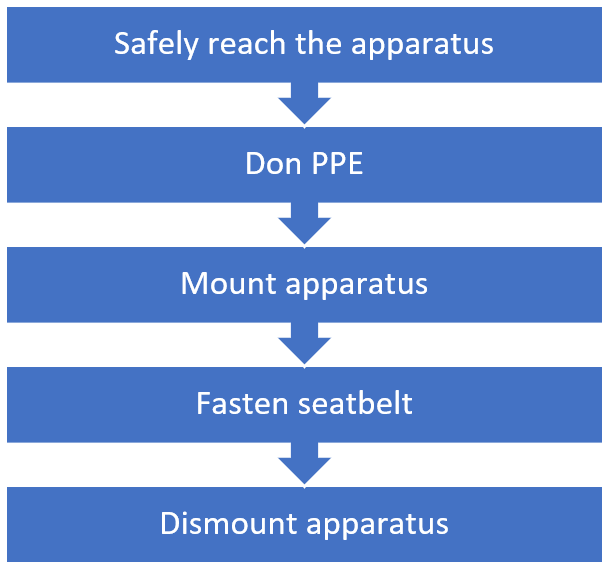

Mounting and Dismounting Apparatus
Mount the apparatus using the available handholds and steps built for that purpose, maintaining three points of contact when mounting or dismounting. Face the apparatus, grip the handholds firmly with both hands then step up into or onto the apparatus. When dismounting, back out of cab using handholds and steps. Do not exit face first as this presents a serious trip or fall hazard.
Exiting the vehicle can be particularly hazardous so always use extreme caution. Whenever possible, it is safest to mount and dismount on the side of the vehicle not exposed to oncoming traffic. If you must dismount on the exposed side, watch for oncoming vehicles before opening any door and wait for a break in traffic before exiting.
Response Hazards for Passengers
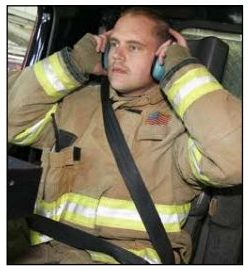
There are numerous hazards to firefighters riding in an apparatus.
-
These may include, but are not limited to:
-
Excessive noise levels that may damage hearing
-
Loose equipment that may strike firefighters
-
Danger of falls inside apparatus if not seated, belted in
-
Danger of injury during vehicle accidents

Safe Practices When Riding Apparatus
Follow your organization’s SOPs, and the requirements listed in NFPA 1500 for riding an apparatus. NFPA 1500 prohibits the wearing of firefighting helmets inside the cab of fire apparatus.
- Additional guidelines for safely riding in and on an apparatus include:
- Always be seated and securely belted before apparatus moves
- Always wear hearing protection or radio headsets
- Secure all loose tools and equipment
- Close cab doors securely
- On an unenclosed apparatus, close safety gates or bars securely
Test your knowledge!
Structural Fire Scene Safety
Responding to any emergency involves risk, but you can minimize your exposures to risk by following the Operational guidelines:
- Follow supervisor’s orders
- Follow departmental SOPs
- Wear appropriate PPE
- Work as team
- Maintain communication with team members, Command
- Do risk/benefit analysis for every action
- Employ safe, effective tactics
- Never operate alone or without supervision
- Perform initial assessment, maintain situational awareness
Situational awareness is critical at any incident scene. Your safety depends on being able to understand what is going on around you and recognize potential threats. All firefighters must train themselves to develop this essential skill.
**NOTE: Many of the topics discussed in this section are also vital elements to incident types other than structural emergency scenes, such as a vehicle crash or a wildland fire. **
Scene Security
Emergency responders typically secure an incident scene by establishing control zones. The scene is cordoned off by tying rope, fireline, or caution tape to stationary object. It is not recommended to tie the rope, line, or tape to a vehicle because vehicles often have to be moved as the incident progresses.
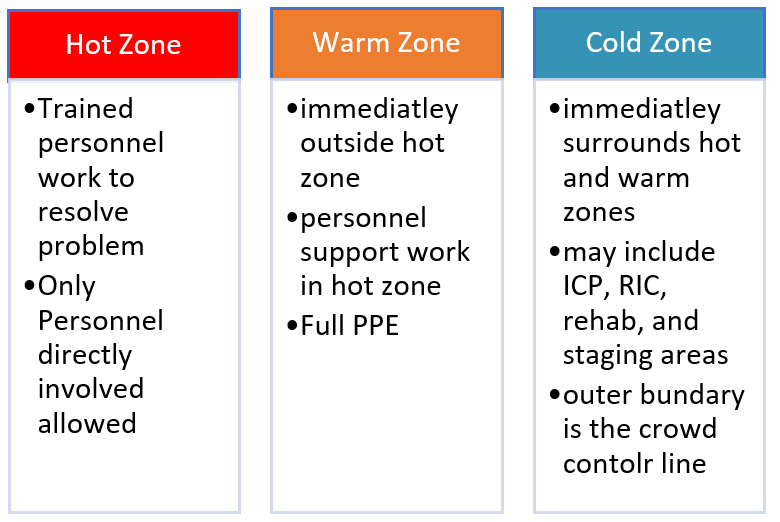
Control zones are called by a variety of names depending upon operations within those zones. The most common terms are Hot zone and Warm zone and Cold zone.
- Hot zone: it is where trained personnel are working to resolve the problem on scene. Only personnel directly involved in disposing of the problem are allowed to enter this zone, which limits crowds and confusion at the most critical area of the scene
- Warm zone: it is immediately outside the hot zone. Personnel in the warm zone directly support personnel working in the hot zone. It is limited to personnel who are operating hydraulic tool power plants and providing emergency lighting and fire protection. Personnel must be in full protective equipment and clothing, and ready to enter the hot zone if needed.
- Cold zone: immediately surround the hot and warm zones and may include the Incident Command Post (ICP), locations of rapid intervention crews (RICs), public information officer (PIO), rehabilitation area, and the staging areas for personnel and equipment. Its outer boundary is the control line for the general public (crowd-control line).
Environmental Conditions
Environmental conditions at a fire scene can affect your performance. Temperature extremes, heavy rains, winds, and lightning all influence your operations and the duration of your ability to perform assigned tasks. As a firefighter you must maintain situational awareness of the environmental conditions and effects.
Emergency Scene Lighting and Equipment
Emergency lighting is required at all incidents that occur at night, in low-light conditions, and inside structures where normal lighting is not available. At an emergency scene you may be assigned to set up portable generators and lighting equipment.
Emergency scene lighting equipment includes:
Electrical generators
Emergency scene lighting and portable rescue equipment are powered by either portable electric generators, the apparatus-mounted generators or the apparatus’ electrical system. Generators are the most common power source used by emergency services personnel. Portable generators are powered by a small gasoline or diesel engines with 110- and/or 220-volt capacity outlets and most are light enough to be carried by two people. These are particularly useful when vehicle-mounted systems are not available.
Lighting equipment
Lighting equipment can be divided into two categories, portable and fixed. Portable lights are used In building interiors or remote areas of the scene. Some are mounted on telescoping stands, which allow them to be raised and used more effectively. Fixed lights are mounted on a vehicle and wired directly to the vehicle-mounted generator or apparatus’ electrical system. They provide the overall lighting of an emergency scene and are usually mounted on telescoping poles that can be raised, lowered, or rotated. Some units may also consist of large banks of lights mounted on hydraulically operated booms. The number of fixed light units mounted on an apparatus is limited by the amount of power the vehicle-mounted generator or apparatus electrical system can produce.
**NOTE: Vehicle-mounted generators produce more power than the portable units and can be powered by gasoline, diesel, propane gas engines, or hydraulic power take-off (PTO) systems. **
Portable lights and equipment may also be powered directly by the apparatus’ electrical system – If small amounts of power are needed to operate lights and tools, an inverter is used to convert the vehicle’s 12 or 24-volt direct current (DC) into 110- or 220-volt alternating current (AC). The advantages of this method include fuel efficiency and minimal noise. The disadvantages, however are a constant apparatus exhaust, limited power supply, and limited mobility.
Auxiliary electrical equipment: All auxiliary electrical equipment must be waterproof, intrinsically safe and designed for the amount of electrical current it is intended to carry.
Electrical cables and extension cords: Can only carry a limited amount of electricity. Cords may be stored in coils, on portable reels, or on apparatus-mounted automatic rewind reels and should have adequate insulation and no exposed wires.
Twist-lock receptacles and connectors: They are equipped with grounding wires which provide secure and safe connections as long as they are not immersed in water.
Junction boxes: They provide multiple outlets or connections and are supplied through one inlet from the power source.
Ground fault circuit interrupter (GFCI) devices: All outlets must be fitted with GFCI devices and meet the requirements outlined in NFPA 70E, Standard for Electrical Safety in the Workplace®.
Adapter connections: These are used to permit different types of plugs and receptacles to be connected. They allow mutual aid departments to operate electrical lights and tools off each other’s generators and power sources. They may also allow fire department lights and tools to be plugged into standard electrical outlets in structures.
Safety Considerations for Emergency Scene Lighting
Emergency scene lighting equipment should be used with caution to ensure safety. The following safety guidelines should be followed when deploying and using emergency scene lighting equipment:
- Use two personnel to carry portable generators to their setup position.
- Ensure generators are positioned downwind so exhaust fumes do not present ignition or contamination hazard.
- Wear hearing protection when operating portable generators if needed.
- Be aware that generator noise can make communications difficult.
- Always adjust lights to height that allows light to be directed toward scene but not into eyes of approaching drivers.
- Remove damaged cords with faulty insulation or exposed wires from service.
- Do not immerse power cords, connections in water.
- Never connect more lights than the power source can support.
To prevent overtaxing the power source, never connect more lights than it can support. This can lead to poor lighting conditions and may even cause damage to the lights, generator, or electrical system. It is crucial to carefully assess the power capacity and ensure that the equipment connected to the power source does not exceed its limits. Certain lighting units used in emergency scenes produce extreme heat and can lead to burns as well as melt paint or plastics on the apparatus. Use extreme caution when moving or turning off these lights to prevent any accidental burns or damage to the surrounding materials.
Placement of Emergency Scene Lighting
When setting up emergency scene lighting, it is important to select the appropriate equipment from the apparatus. If an generator is apparatus-mounted then you will gather the lights, cords, and adapters needed and carry them to the setup location(s). In the case of portable generators, take extra care to carry them to a safe location before proceeding with the setup process.
Personnel Accountability
Personnel accountability systems are designed to track personnel, both in and out of the IDHL environment. All departments use some type of accountability system at every incident. All personnel should be trained in its use, and it should be a part of all training exercises.
An accountability system can save your life if your SCBA malfunctions, you become lost or trapped, or there is an unexpected change in a fire’s behaviour. If the IC does not know the location of personnel at a fire scene, it is impossible to determine whether someone is trapped inside. Firefighters have died because they were not known to be missing until it was too late.
A variety of accountability systems exist. These include passport systems, SCBA tag systems, and computer based electronic systems. These systems are only effective if they are properly implemented by the IC and used by the personnel at the incident.
Passport System
Passport systems, otherwise known as a tag system, contain a passport listing for every member of the crew, the company officers (CO) are responsible for the management of this system. Firefighters give passports/tags to the supervisor or designated accountability officer per department policy. Passports are attached to the control board or personnel identification chart. Firefighters must collect their passports after leaving IDHL. This allows Command to know which companies and personnel are operating and where.
SCBA Tag System
A tag attached to the SCBA can provide more accountability and greater safety to the firefighters on scene. Firefighters will give their tags to the AO who records their time of entry, expected time of exit based on the air pressure in the lowest-reading SCBA in their team. Firefighters leaving the IDHL environment take back their tag, so the AO knows who is still inside. During extended operations, relief crews are sent in before the crews run low on air.
Computer Based Electronic Accountability Systems
Computer based electron accountability systems provide a greater level of safety to fire service operations. These systems use radio-based tracking or radar-based transmitters attached to PPE. Most systems sound an alarm if a firefighter becomes immobile or calls for assistance. They can also sound MAYDAY or an evacuation alarm and verify it has been received by IC or other firefighters.
Some SCBA manufacturers developed units with digital accountability features. The SCBA is stored in a riding position on the apparatus. At the beginning of the work shift, personnel “log-in” to their assigned SCBA. When they arrive at an incident, their position and air supply automatically register on IC’s tracking software within the command unit.
Electronic systems should never fully replace manual accountability systems such as Passport and SCBA tag systems. They should only be used as a supplemental safety measure.
Highway/Roadway Incident Scene Safety
At motor vehicle fires and accidents, both firefighters and victims are in danger of being struck by traffic. To ensure your safety, you must be visible, work within a protected area, and exercise situational awareness.
Apparatus lights and scene lighting also contribute to visibility, but they can make situations more hazardous if improperly used. Some departments limit their use and require responders to:
- Turn off all forward-facing lights, including headlights.
- Minimize flashing lights on vehicle’s sides and rear.
- Turn off lights that face approaching traffic, to avoid blinding or distracting drivers.
- Turn off all headlights unless being used to Illuminate a work area or warn motorists that a vehicle is in unexpected location
General guidelines for maintaining situational awareness at a roadway incident are:
- Look before you move.
- Keep an eye on moving traffic.
- Walk facing oncoming traffic.
- Follow departmental SOPs.
Scene management during incidents on streets and highways can be critical to preventing firefighter injuries or fatalities.
Highway/Roadway Incident Hazards
Emergency responders can encounter several hazards at highway/roadway incidents related to the vehicle(s) involved and the surrounding area. Common highway/roadway incident hazards include but are not limited to:
- Debris: Vehicle crashes can spread debris over a large area around an incident scene. This can pose tripping and fall hazards. The edges of some pieces may be sharp and pose danger to responders. Personnel should exercise caution to avoid trips, falls, or cuts.
- Fuel spills: Damaged fuel tanks or lines can lead to fuel spills at vehicle accidents. These spills can present significant fire danger to rescuers and victims. Firefighters standing by with a charged handline should wear full PPE and SCBA.
- Hydraulic and battery fluid spills: This type of spill can cause toxic reactions, skin irritation, and burns. Firefighters should avoid coming in contact with these materials and cover spills with approved absorption materials. First aid may be required if someone comes in contact with these materials.
- Downed high-voltage power lines: A Vehicle striking a power pole can sever a high-voltage line that falls onto the vehicle. The First priority is to contact the electric company to shut off power. With the power off the incident becomes a vehicle extrication incident.
Electrical wires on the ground can be dangerous without being touched. Downed lines can energize wire fences or other metal objects with which they come in contact. Wires in contact with the ground cause current to flow outward in all directions from the point of contact. As the current flows away from the point of contact, the voltage drops progressively. This energized area is called the ground gradient. Depending on voltage and other variables, such as ground moisture, it can extend for several yards (meters) from point of contact. To avoid this hazard, estimate the distance between two nearby power poles, and stay that distance away from the downed line until you are sure the power is off.
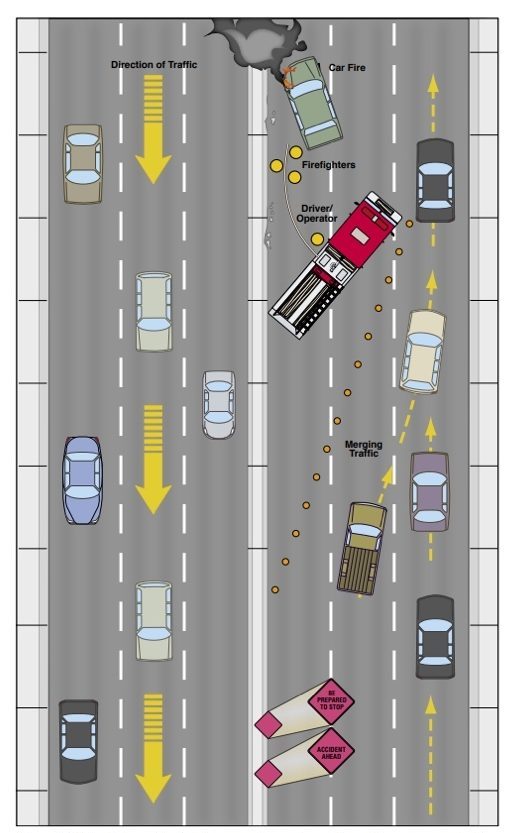
Traffic Incident Management
Establish traffic control zones for any incident on or near a highway/roadway. Personnel should coordinate a traffic management system with local law enforcement to ensure responder and civilian safety. The Manual on Uniform Traffic Control Devices (MUTCD) describes the minimum requirements for establishing traffic control zones.
A traffic control zone may have hot, warm and cold zones within it depending on the type of hazard. Fire departments should coordinate traffic control zones with local law enforcement to ensure an appropriate safe working zone while maintaining as much traffic flow as is reasonably possible.
Traffic Control Measures and Devices
Use emergency vehicles to form a protective barrier between oncoming traffic and working personnel. The company officer and driver/operator are responsible for positioning the emergency vehicle to form that barrier. Signs and traffic cones are also used to detour traffic around the emergency scene. Firefighters should deploy them in order to close off at least one lane of traffic next to the scene. Traffic control assistance should be requested from local law enforcement.
Chapter Review

